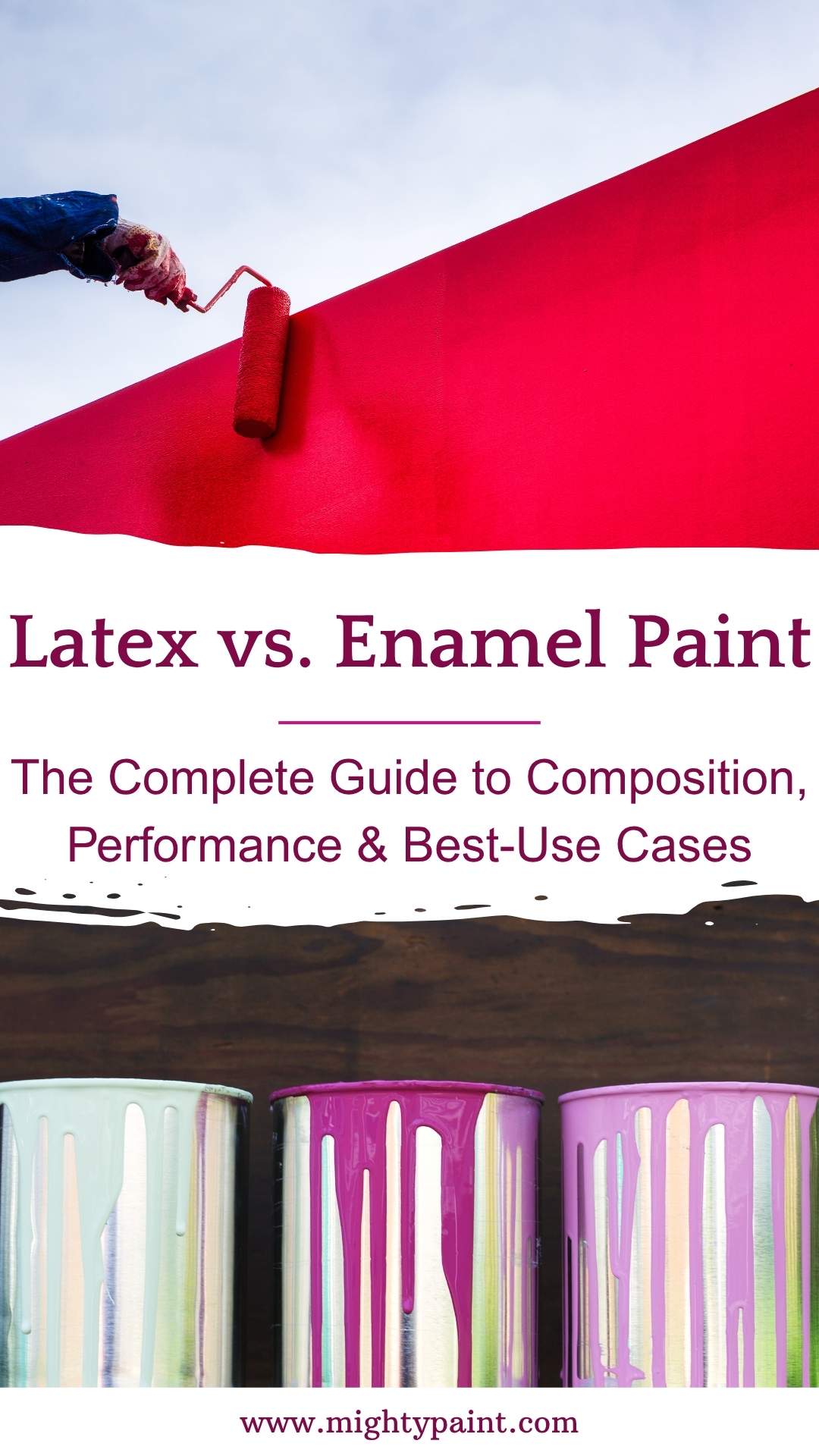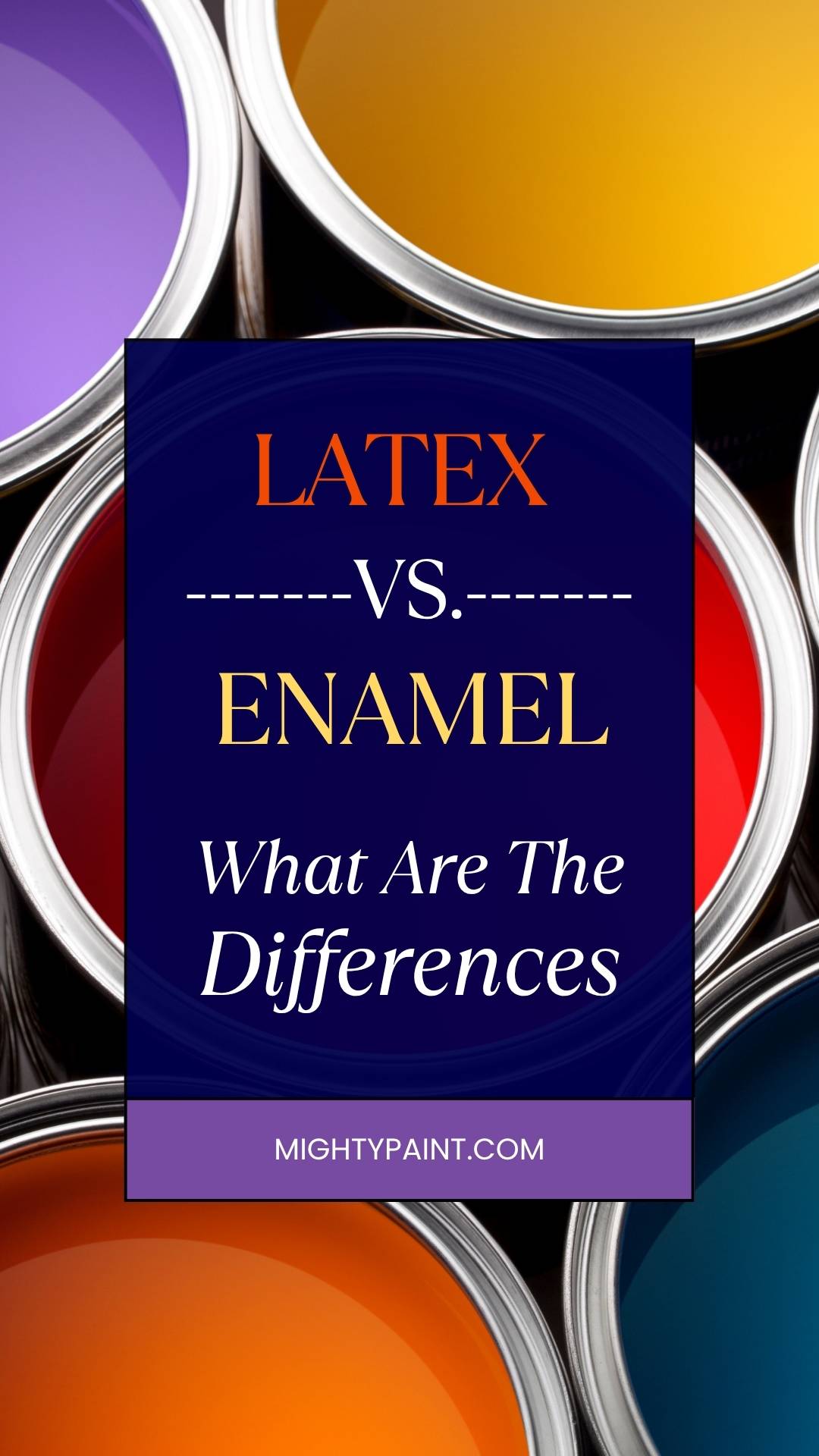Latex vs. Enamel Paint: Which One Wins for Your Walls?
I learned the hard way that “paint is paint” is a dangerous assumption. Last spring, I rolled what I thought was a durable trim color onto my son’s bedroom baseboards. It looked flawless—until the first toy truck clipped the corner and peeled off a perfect postage-stamp of color. That’s when a pro friend asked the question I should’ve started with: “Was that latex or enamel?”

On the surface the two sound interchangeable; both cans promised easy coverage and a satin sheen. Under the lid, though, latex dries fast but stays slightly rubbery, while true enamel cures into a rock-hard shell that laughs at Hot Wheels collisions. Flexibility versus hardness, water cleanup versus mineral spirits, breathability versus weather resistance—the trade-offs run deeper than marketing labels suggest, especially now that “waterborne enamels” and “acrylic-latex hybrids” blur the line even further.
Get the Fail-Safe Paint Color Playbook (Free PDF)
36 proven colors • 8 ready palettes • trim & sheen guide • printable testing cards.
If you’re staring at the paint aisle wondering which formula belongs on drywall, which survives a steamy bathroom, or whether you can safely coat metal railings without a primer nightmare, you’re in the right place. By the end of this guide you’ll know exactly how latex and enamel differ in composition, durability, application, cost, and even environmental impact—plus when modern hybrid formulas might give you the best of both worlds.
Setting the Stage: Why the Confusion Exists
If you leaf through a paint aisle today you’ll see cans screaming “100 % Acrylic Latex,” others bragging “Premium Enamel,” and still more combining both words on the same label. No wonder people use the terms as if they’re twins. Historically, though, they lived on opposite ends of the chemistry spectrum.
“Enamel” once meant an oil-based formula that cured as hard as a baked-on appliance finish, while “latex” referred to the first water-borne wall paints that cleaned up with soap and dried in under an hour.
Two developments blurred that tidy divide. First, stricter VOC regulations pushed manufacturers to invent water-borne alkyds—products that behave like oil but rinse with water. Second, marketers started slapping the word “enamel” on any paint that dried to a higher sheen or tougher finish, even if it was water-based. The result is a vocabulary gap where shoppers think they’re choosing between colors, when they’re really choosing between completely different resin systems.
What Exactly Is Latex Paint?
Latex paint isn’t made from natural latex rubber; the name stuck from early experiments. Today’s cans hold microscopic acrylic or vinyl-acrylic spheres suspended in water. As the water evaporates, those spheres fuse into a flexible, breathable film.
Core strengths
- Fast dry & recoat – touch-dry in 30 minutes, second coat within two hours.
- Low odor & easy cleanup – soap, water, done.
- Flexibility – expands and contracts with wood or plaster, so it rarely cracks.
Because it lets moisture escape, latex shines on drywall, masonry, and exterior siding in variable climates. Its weakness is hardness: even when fully cured it stays slightly rubbery, which is why a toy truck can gouge it off trim.
What Exactly Is Enamel Paint?
Traditional enamel builds its durability on solvent-based alkyd resins that react with oxygen as they dry. This oxidative cure forms long chains that create a rock-hard surface—great for doors, cabinets, metal railings, and any spot that sees abrasion or repeated cleaning.
Modern shelves also hold “waterborne enamel.” These hybrids replace harsh solvents with water yet still cross-link into a tougher shell than standard latex. They give you much of the scratch resistance of oil without the lingering fumes or mineral-spirit cleanup.
Get the Fail-Safe Paint Color Playbook (Free PDF)
36 proven colors • 8 ready palettes • trim & sheen guide • printable testing cards.
| Key Attribute | Classic Oil Enamel | Waterborne Enamel | Standard Latex |
|---|---|---|---|
| Cleanup | Mineral spirits | Soap & water | Soap & water |
| Hardness | Highest | High | Moderate |
| Dry Time (recoat) | 6–24 h | 2–4 h | 1–2 h |
| Yellowing Risk | Moderate over time | Low | None |
| VOC Level | High (regulated) | Low / Med | Low |
The payoff for that hardness is patience: enamels level beautifully but need longer open time, good ventilation, and a dust-free environment while they cure. Use them where sheer toughness outweighs speed.
Latex vs Enamel: A Deeper, Side-by-Side Comparison
Most decisions come down to “How will it look tomorrow, and how will it hold up five years from now?” The answers live in six key arenas: chemistry, adhesion, durability, sheen, health + environment, and cost. Here’s how each paint type truly stacks up.
1. Chemistry & Cure Mechanism
Latex is a water-borne acrylic (or vinyl-acrylic) dispersion. Water evaporates, the polymer spheres fuse—job done in two hours.
Enamel (classic oil) relies on alkyd resins that oxidatively cross-link for days, forming a dense network. Modern waterborne enamels suspend tiny alkyd droplets in water, so they clean up like latex but still cross-link as they dry.
2. Adhesion & Breathability
- Latex grips porous substrates (drywall, brick) without pulling away when wood swells; its film lets ~20 perm of moisture vapor escape.
- Enamel bites harder onto slick surfaces (primed metal, cabinets) but has a low vapor-perm rating (~3–5), meaning trapped moisture blisters it faster on damp walls.
- Rule of thumb: Latex for anything that needs to “breathe”; enamel for surfaces you wipe or slam every day.
3. Durability & Surface Hardness
*Higher letter = harder film. Latex sacrifices hardness for flexibility; enamel flips those priorities.
Get the Fail-Safe Paint Color Playbook (Free PDF)
36 proven colors • 8 ready palettes • trim & sheen guide • printable testing cards.
4. Sheen Retention & Color Shift
Latex holds color in dark rooms because the acrylic backbone doesn’t yellow. High-gloss latex, however, can telegraph roller stipple.
Oil enamel self-levels into a glassy sheet, perfect for furniture, but its alkyd resins slowly amber—most obvious in whites. Waterborne enamels split the difference: minimal yellowing, decent leveling, quicker recoat.
5. Health, VOCs & Clean-Up
- Latex: 0–50 g/L VOC (meets strict CA rules). Cleans with soap and water—ideal for occupied homes.
- Oil Enamel: 250–450 g/L VOC; requires mineral spirits and active ventilation. Many states now restrict retail sales over 350 g/L.
- Waterborne Enamel: 50–150 g/L VOC; soap-and-water cleanup but still off-gasses longer than latex.
If someone in the household has asthma or you’re painting in winter with closed windows, latex or low-VOC waterborne enamel is the safer play.
6. Cost & Labor Reality
| Gallon Price* | Typical Coverage | Extra Materials | Total Labor Time (avg room) |
|---|---|---|---|
| Latex $35–$55 | 350–400 sq ft | Few—just rollers & water | Paint + cleanup ≈ 4 h |
| Oil Enamel $50–$70 | 300–350 sq ft | Mineral spirits, disposal bags | Paint + cleanup ≈ 8 h |
| Waterborne Enamel $55–$75 | 320–380 sq ft | Quality synthetic brush, extender | Paint + cleanup ≈ 6 h |
*Retail mid-grade; regionally variable.

When Latex Paint Is the Smarter Choice
Most of my quick-turn projects—living-room walls, nursery trim, even the concrete basement stairwell—use latex, and here’s why. First, the fast dry means I can paint a room after work and move furniture back before bed. Second, low odor keeps the household blissfully complaint-free. Finally, latex flexes with shifting humidity, so hairline cracks stay sealed instead of broadcasting every seasonal change.
Latex shines on:
- Large interior walls where speed and low fumes trump armor plating.
- Exterior siding or masonry that needs to breathe; trapped moisture is the enemy of both paint and framing.
- Rooms with wide temperature swings (sunrooms, unconditioned attics) where flexibility prevents peel-offs.
- Kid spaces—washable acrylic formulas now shrug off crayons and PB&J fingerprints almost as well as enamel.
Budget also tilts toward latex: a good gallon often costs 20 – 30 % less than its enamel counterpart, and you’re not buying solvents for cleanup.
When Enamel Paint Earns Its Keep
Enamel enters the chat whenever the surface will be slammed, scrubbed, or weather-beaten. I learned this after repainting an entry door twice in three years—latex just couldn’t survive keys, dog paws, and summer sun. Switching to a waterborne enamel fixed the problem and still let me clean brushes in the sink.
Enamel is worth the extra steps on:
- Cabinet doors and drawer fronts that endure greasy fingers and daily wipe-downs.
- Baseboards in high-traffic hallways where toys and vacuum cleaners attack the corners.
- Exterior doors, metal railings, and patio furniture that need chip resistance plus UV toughness.
- Furniture makeovers—a cured enamel topcoat shrugs off drink rings better than most clear varnishes.
Expect to trade speed for stamina. Enamel’s longer open time demands dust control and a cat-free zone, but the polished, rock-hard finish repays the favor every time someone slams the door or slides a plate across the counter.
Prep & Application Differences
A good finish depends as much on how you put paint on as on what’s inside the can. I’ve botched enough projects to treat prep and tools as non-negotiable steps, not suggestions.
Surface Prep Matters
- Latex forgives light sanding and a quick dust-off, but it still needs a sound, dull surface.
- Enamel insists on extra diligence: de-gloss slick factory finishes, wipe with a solvent cleaner, and spot-prime any raw patches so the film can bite.
Tool Choices & Technique
| Tool | Best For | Why It Works |
|---|---|---|
| Synthetic-bristle brush | Latex & waterborne enamel | Holds water-based paint without swelling. |
| Natural-bristle brush | Oil enamel | Fibers stay stiff in solvents, leave fewer brush marks. |
| Microfiber roller (¼–⅜ in nap) | Large flat walls (latex) | Lays a thin, even coat that levels out quickly. |
| Foam roller or HVLP sprayer | Cabinets, doors (enamel) | Minimizes orange-peel, maximizes flow-out. |
Keep a wet edge—especially with latex, which can film over in minutes. For enamel, add a splash of manufacturer-approved extender if you see brush drag; it buys leveling time without wrecking the cure.
Recoat Etiquette
Latex lets you sand lightly and hit it again in an hour or two. Enamel likes a 220-grit nib-sand and a full afternoon to breathe. Rushing either one invites the nemesis of every DIY painter: “mystery tacky”—that gummy feel that never quite goes away.
Get the Fail-Safe Paint Color Playbook (Free PDF)
36 proven colors • 8 ready palettes • trim & sheen guide • printable testing cards.
Cost, Environmental & Health Considerations
Latex wins the checkout lane but the real savings show up in cleanup time and ventilation gear you don’t have to buy. A gallon of quality interior latex runs USD 25–35; equivalent enamel often creeps past USD 45 once you add the right thinner and conditioner.
| Factor | Latex | Oil Enamel | Waterborne Enamel |
|---|---|---|---|
| Typical Price / gal | $25–35 | $45–55 | $40–50 |
| VOC Range | 0–150 g/L | 250–450 g/L | 50–150 g/L |
| Disposal | Dry-out & trash | Hazardous-waste drop-off | Dry-out & trash |
Regulations tighten every year. In some U.S. states you can’t even buy classic oil enamel off the shelf. If odor sensitivity or asthma is a household issue, low- or zero-VOC latex (and select hybrids) are peace-of-mind choices.
Modern Hybrids & “Best of Both Worlds” Options
Paint chemists hate either-or dilemmas, so they invented workarounds.
Waterborne Alkyd Enamels
My current favorite for doors and baseboards, these suspend tiny alkyd droplets in water. You get the flow and hardness of oil with soap-and-water cleanup. Dry to touch in about two hours, sandable after four.
Get the Fail-Safe Paint Color Playbook (Free PDF)
36 proven colors • 8 ready palettes • trim & sheen guide • printable testing cards.
Acrylic-Urethane Fortified Latex
Think “latex on protein powder.” Added urethane bumps scratch resistance without sacrificing flexibility. I use it in bathrooms where steamy showers punish ordinary wall paint.
One-Day Cabinet Coatings
Pro-grade kits combine bonding primer and high-build enamel in a two-step, same-day system. They cost more per quart but erase the 48-hour cure headache traditional enamels require before reinstalling doors.
Tip: Hybrid or not, always read the data sheet. Some hybrids still call for a light solvent wipe or a specialty primer to reach their published adhesion numbers.
Quick-Reference FAQ
- Can I put latex over enamel?
Yes, but only after a thorough de-gloss and a bonding primer—otherwise it will peel like sunburned skin. - Can I put enamel over latex?
Usually. Wash, sand to a dull finish, tack-cloth, and you’re good. A stain-blocking primer helps where crayon art or cooking grease lurk. - Does enamel always yellow?
Classic oils tend to amber in low light; waterborne versions stay white far longer. - Is there a truly zero-VOC enamel?
Not in the traditional sense, but several waterborne alkyds now clock in under 50 g/L—low enough for most green-build specs.
Conclusion
Choosing between latex and enamel is less about right versus wrong and more about matching a resin’s personality to the job. Latex rewards speed, easy cleanup, and surfaces that need to breathe. Enamel—whether classic oil or modern waterborne—brings the muscle for doors, trim, and high-traffic abuse, trading patience for permanence. Hybrids blur the line even further, letting you pick hardness, sheen, and VOC level like sliders on a mixing board.
So before you pick a color, decide what the surface really faces: flex or fists, steam or sun, constant fingerprints or gentle glances. Match those demands to the chemistry, and your next paint job will outlast even the boldest design trend—toy-truck collisions included.
Get the Fail-Safe Paint Color Playbook (Free PDF)
36 proven colors • 8 ready palettes • trim & sheen guide • printable testing cards.
